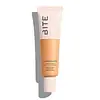What's inside
What's inside
 Benefits
Benefits

No benefits
 Concerns
Concerns

No concerns
 Ingredients Side-by-side
Ingredients Side-by-side

Water
Skin ConditioningC13-15 Alkane
SolventPropanediol
SolventIsododecane
EmollientPolyglyceryl-6 Polyricinoleate
EmulsifyingMica
Cosmetic ColorantPolymethylsilsesquioxane
Dimethicone
EmollientTrimethylsiloxysilicate
EmollientCaprylic/Capric Triglyceride
MaskingStearoxymethicone/Dimethicone Copolymer
EmollientCoco-Caprylate/Caprate
EmollientPolyglyceryl-10 Dioleate
EmulsifyingDisteardimonium Hectorite
StabilisingHydrogenated Lecithin
EmulsifyingSucrose Polystearate
EmollientSucrose Stearate
EmollientGlyceryl Caprylate
EmollientC24-28 Alkyl Methicone
EmollientPropylene Carbonate
SolventParfum
MaskingGlyceryl Undecylenate
EmollientXanthan Gum
EmulsifyingSodium Hydroxide
BufferingHelianthus Annuus Seed Oil
EmollientMaltose
MaskingAgave Tequilana Leaf Extract
AstringentTriethoxycaprylylsilane
Aristotelia Chilensis Fruit Extract
Skin ConditioningHexyl Cinnamal
PerfumingLinalool
PerfumingLimonene
PerfumingCI 77891
Cosmetic ColorantIron Oxides
Water, C13-15 Alkane, Propanediol, Isododecane, Polyglyceryl-6 Polyricinoleate, Mica, Polymethylsilsesquioxane, Dimethicone, Trimethylsiloxysilicate, Caprylic/Capric Triglyceride, Stearoxymethicone/Dimethicone Copolymer, Coco-Caprylate/Caprate, Polyglyceryl-10 Dioleate, Disteardimonium Hectorite, Hydrogenated Lecithin, Sucrose Polystearate, Sucrose Stearate, Glyceryl Caprylate, C24-28 Alkyl Methicone, Propylene Carbonate, Parfum, Glyceryl Undecylenate, Xanthan Gum, Sodium Hydroxide, Helianthus Annuus Seed Oil, Maltose, Agave Tequilana Leaf Extract, Triethoxycaprylylsilane, Aristotelia Chilensis Fruit Extract, Hexyl Cinnamal, Linalool, Limonene, CI 77891, Iron Oxides